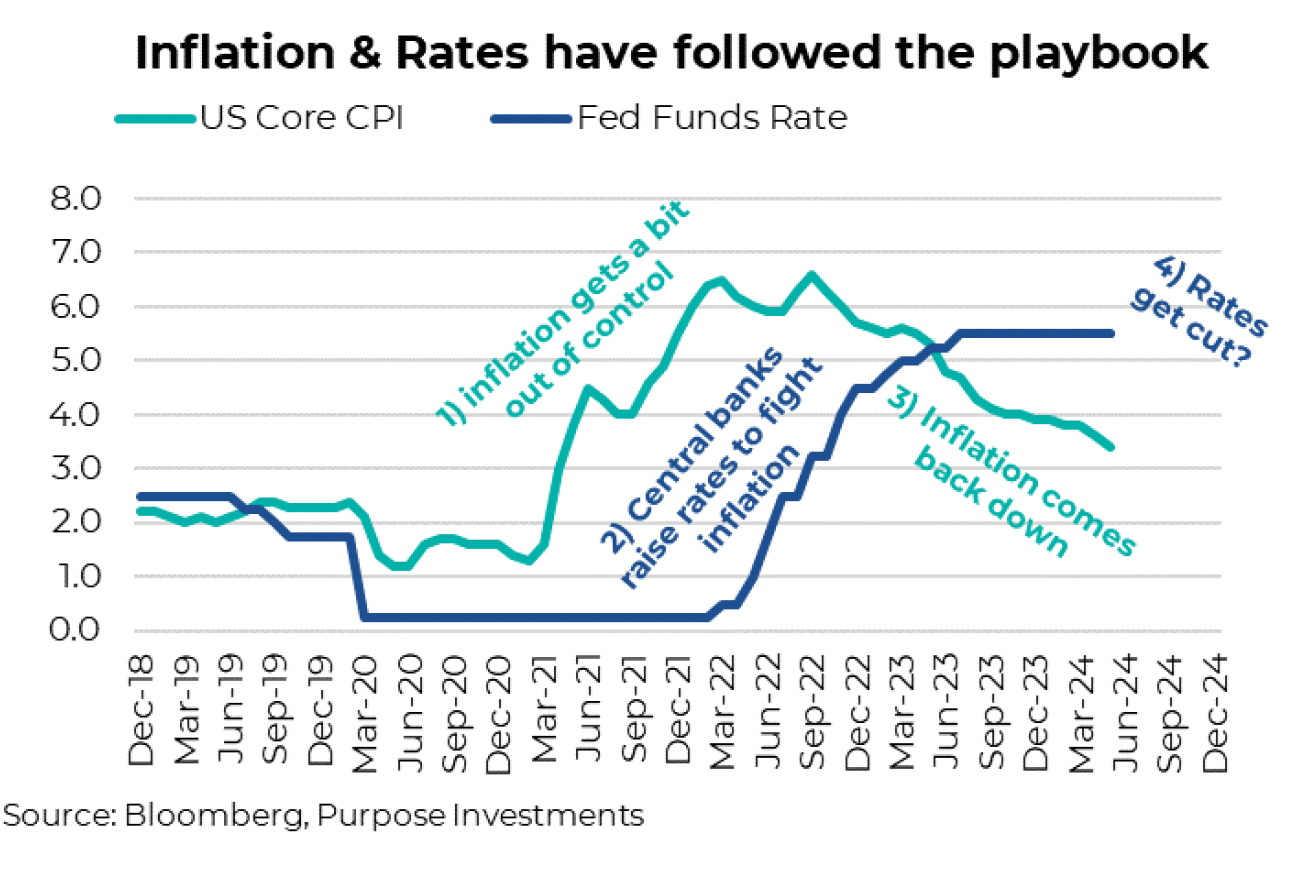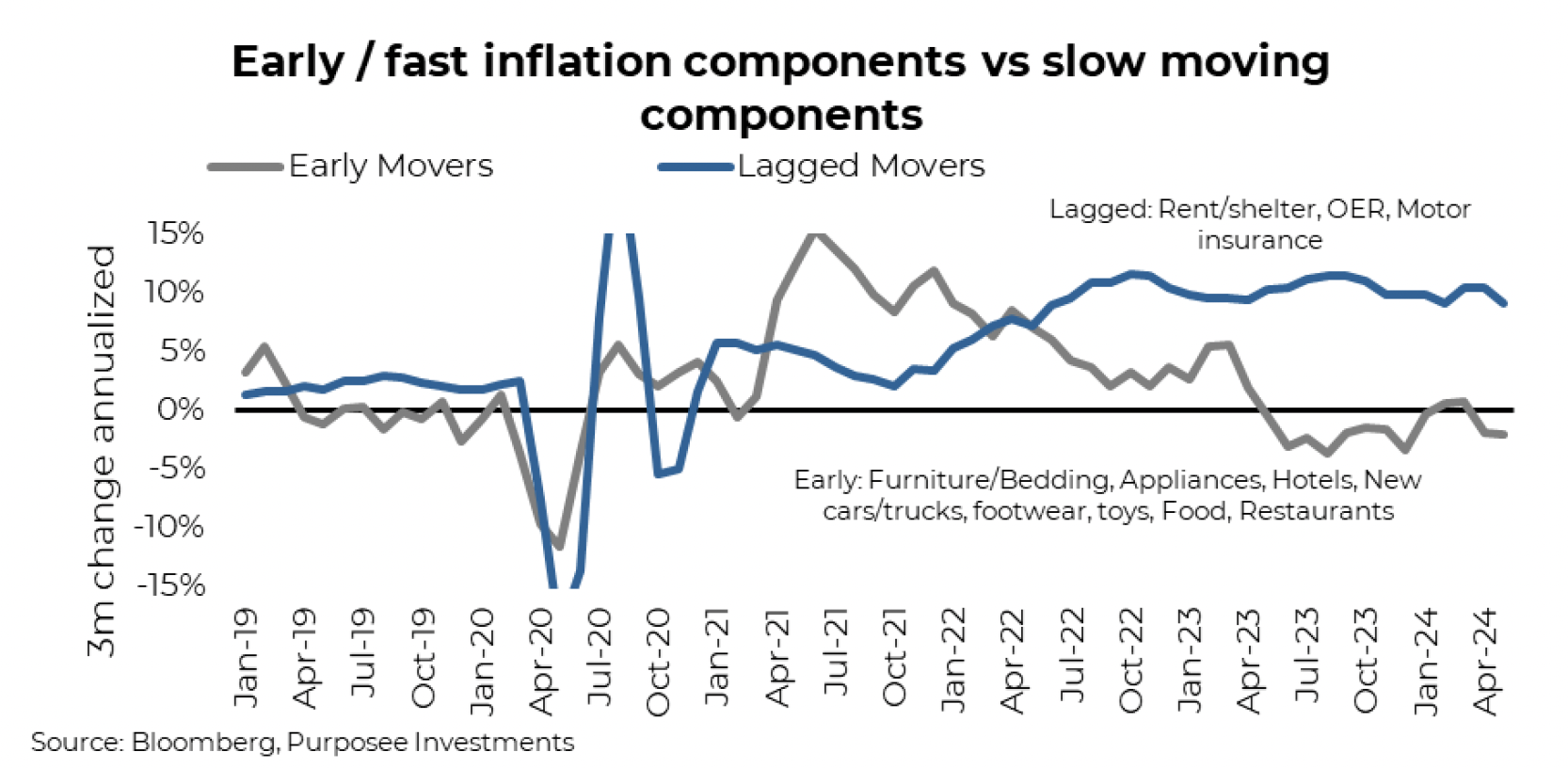Is it over?
It seems like just yesterday that you could buy a pint of Stella for $7 or so. Now, more often than not, it is closer to $10. Yep, inflation. It is kind of like a tax on doing things, as just about everything has cost more over the past few years. Hop on a flight, eat at a nice restaurant, refinance your mortgage, the list goes on. With the benefit of hindsight, the current higher inflationary environment can be blamed on a few pretty big factors. Changes in behaviour during and coming out of the pandemic blew up supply changes, as capacity was unable to keep pace with demand. Then, of course, unprecedented money printing magnified the situation, as it made everyone wealthier and more willing to pay $10 for a pint.
Of course, the textbook solution is to raise interest rates, which is clearly occurring around the world. These monetary policy shifts are effective but do work with variable lags. Making those lags longer, or even temporally offsetting them, was fiscal policy. It doesn’t take an economist to understand if the monetary policy is trying to slow the economy to tame inflation; materially elevated fiscal spending in an economy that is still growing at a decent pace is counterproductive for the inflation fight.

Despite contrary policies, perhaps motivated by short-term thinking (or upcoming elections), inflation has taken a decent turn down and continues to cool – but clearly, not in a straight line. You can note a quicker decline in the greenish line tracking U.S. year-over-year core inflation with the latest reading after a period where little progress was made. This chart really goes back to show how inflation got started. It was initially called ‘transitory,’ and then, finally, central banks jumped into action coincidentally when inflation had already peaked. Rarely ahead of the curve, those central bankers. Inflation declined a good amount in 2023, but the previous few months in 2024 showed it picking up or being much more sticky. This latest reading has things cooling again, which is good news.
The above is U.S. inflation, but the pattern is similar around the world for the most part. Inflation and the economy in Canada have cooled enough to open the door for the Bank of Canada to cut. In fact, the number of central banks cutting rates has been on the rise, including some of the biggies like the BoC and ECB. We will talk more about U.S. inflation simply because that is what moves global markets more.
The fast or early movers in the CPI data have been improving for some time. These are the categories of CPI that simply change faster, as other components are much slower to react to changes in behaviour. Many goods categories, such as hotels, autos, and restaurants, are examples of areas of the economy that change prices rather fluidly. Rent, owner-occupied rent, and insurance are examples of areas where prices change very slowly or are even lagged in their reaction. Rents often don’t reset until the end of a lease and are further slowed by rent controls. Insurance, too, doesn’t reset often, so changes in actual prices take time to show up in the aggregate data.

This chart breaks focused on a number of early or fast movers vs slower or lagged. Clearly, since the spring of ’23, we have seen the fast-moving components showing some disinflationary pressures. But the lagged movers remained high, owing to their name. Yet of late, those, too, have finally started to turn down a bit.
Where to next?
Back down to 3% or so is likely the easy part; then things get a bit less clear cut. Helping out, there remain a number of factors that should continue to put downward pressure on inflation:
- The nature of the price resetting in the lagged movers should continue to put some downward pressure on overall inflation.
- Given how much of inflation is services, employment certainly matters. While nonfarm payrolls remain healthy, that is contrary to other metrics. Household survey is less enthusiastic, and temp workers remain on the decline and job openings continue a downward trend. Quitters, too, the quit rate drops
should help on wages and the flow through to inflation. - Supply chain bottlenecks are very low again. And China PPI, producer prices, remain negative. Given its global manufacturing market share, lower prices for goods coming out of China is disinflationary.
But don’t get too excited. While we think inflation will likely cool a bit more, there are some counterforces that will probably limit the improvements.
- Over the past few months, global trade and manufacturing activity have been turning back up. This could just be an echo coming out of the manufacturing recession of '22/early ’23, or it may have longevity. Regardless, in the near term, rising global economic activity will not help prices to go down.
- Price intentions among survey data, which improved a lot last year, have stabilized. Companies will charge as much as they can, and given consumers continued fortitude to suck it up and pay higher prices, well, that keeps prices higher. There is some evidence the consumer is starting to change, but for now, they keep hitting the ask for flights, trips, dinners, etc.
Inflation may fall further, but the gains are likely getting harder to come by.
Final thoughts
We do believe inflation is likely back to being influenced more by the economy and less by the pandemic-induced gyrating behaviours. If the economy reaccelerates, we could easily see inflation pick up again. And if the recent uptick in economic growth proves fleeting, inflation will likely back down. At the very least, this is an easier world to navigate compared to the previous years.
Source: Charts are sourced to Bloomberg L.P. and Purpose Investments Inc.
The contents of this publication were researched, written and produced by Purpose Investments Inc. and are used by Echelon Wealth Partners Inc. for information purposes only.
This report is authored by Craig Basinger, Greg Taylor and Derek Benedet Purpose Investments Inc.
The contents of this publication were researched, written and produced by Purpose Investments Inc. and are used herein under a non-exclusive license by Echelon Wealth Partners Inc. (“Echelon”) for information purposes only. The statements and statistics contained herein are based on material believed to be reliable but there is no guarantee they are accurate or complete. Particular investments or trading strategies should be evaluated relative to each individual's objectives in consultation with their Echelon representative.
Echelon Wealth Partners Ltd.
The opinions expressed in this report are the opinions of the author and readers should not assume they reflect the opinions or recommendations of Echelon Wealth Partners Ltd. or its affiliates. Assumptions, opinions and estimates constitute the author's judgment as of the date of this material and are subject to change without notice. We do not warrant the completeness or accuracy of this material, and it should not be relied upon as such. Before acting on any recommendation, you should consider whether it is suitable for your particular circumstances and, if necessary, seek professional advice. Past performance is not indicative of future results. The comments contained herein are general in nature and are not intended to be, nor should be construed to be, legal or tax advice to any particular individual. Accordingly, individuals should consult their own legal or tax advisors for advice with respect to the tax consequences to them.
Purpose Investments Inc.
Purpose Investments Inc. is a registered securities entity. Commissions, trailing commissions, management fees and expenses all may be associated with investment funds. Please read the prospectus before investing. If the securities are purchased or sold on a stock exchange, you may pay more or receive less than the current net asset value. Investment funds are not guaranteed, their values change frequently and past performance may not be repeated.
Forward Looking Statements
Forward-looking statements are based on current expectations, estimates, forecasts and projections based on beliefs and assumptions made by author. These statements involve risks and uncertainties and are not guarantees of future performance or results and no assurance can be given that these estimates and expectations will prove to have been correct, and actual outcomes and results may differ materially from what is expressed, implied or projected in such forward-looking statements. Assumptions, opinions and estimates constitute the author’s judgment as of the date of this material and are subject to change without notice. Neither Purpose Investments nor Echelon Partners warrant the completeness or accuracy of this material, and it should not be relied upon as such. Before acting on any recommendation, you should consider whether it is suitable for your particular circumstances and, if necessary, seek professional advice. Past performance is not indicative of future results. These estimates and expectations involve risks and uncertainties and are not guarantees of future performance or results and no assurance can be given that these estimates and expectations will prove to have been correct, and actual outcomes and results may differ materially from what is expressed, implied or projected in such forward-looking statements. Unless required by applicable law, it is not undertaken, and specifically disclaimed, that there is any intention or obligation to update or revise the forward-looking statements, whether as a result of new information, future events or otherwise.
Before acting on any recommendation, you should consider whether it is suitable for your particular circumstances and, if necessary, seek professional advice.
The particulars contained herein were obtained from sources which we believe are reliable, but are not guaranteed by us and may be incomplete. This is not an official publication or research report of either Echelon Partners or Purpose Investments, and this is not to be used as a solicitation in any jurisdiction.
This document is not for public distribution, is for informational purposes only, and is not being delivered to you in the context of an offering of any securities, nor is it a recommendation or solicitation to buy, hold or sell any security.



CLIENT LOGIN

L.I.F.E. Wealth Management Inc.
Please note that only Ventum Financial Corp.
is a member of CIPF and regulated by IIROC;
Ventum Insurance Services
is not.
*Insurance Products provided through Ventum Insurance Services.
Website Links


